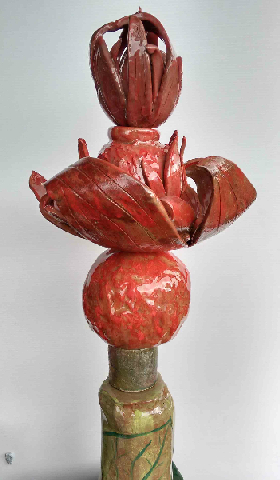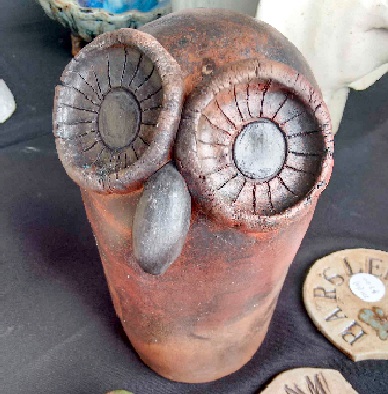|
Thank you Marienne for a very informative workshop. This was held on October 31, 2015.
A glaze quite simply is a thin glassy covering fused to the body of a pot. It is composed of a glass former, fluxes, a glass stiffener and colourants. When fired the ingredients melt together to form a glaze. Prepare the work space Gather what you need before beginning to glaze. You may need pouring mugs, suitable glaze containers for awkward shapes, water, sponges, stirrers, glaze tongs, sticks, large containers. It is all too easy to dip your pot in a glaze and hope for the best. Put as much thought into this process as you did in making the piece and you won’t be disappointed .Record what you have done. Clean the ware before glazing to remove dust. Dust can cause pin holes in the glaze or worse, crawling .Remove any rough bits. Bisqueware should not be fired higher than 1000 degrees otherwise it won’t be porous enough to accept the glaze .If a piece has been fired higher, heat it up in the oven first. A small cup of whiting placed in the kiln will help to control sulphur fumes .It can be re used. Glazes To make up a glaze from a recipe weigh out all the ingredients carefully. Tick them off. Wear a mask as the fine powder becomes airborne. Lightly mix the dry ingredients together and sprinkle into the measured amount of water. Roughly 1 kilo of dry weight to1 litre of water. Leave to slake overnight. Put through a fine sieve 100-120 mesh taking care that all ingredients go through. I always take some water out of the bucket before stirring ,mix it up, test with my finger and a bisque tile –fired no higher than 1000. Do not use a setter which has been fired in the glaze kiln. If too thick I re add the water bit by bit. A simple guide to test the thickness is to dip a dry finger into the glaze fairly quickly. If you cannot see the outline of your finger then the glaze is too thick If you can see the colour of your finger through the glaze it is too thin. The shape of your nail should be discernible through an opaque layer of glaze. Very scientific I know! Decision time Do you glaze it or bin it? Give it some thought. If you hated the pot before you glazed it, it is highly improbable that you will love it later, after you paid to have it fired. Stir glaze which settles quickly and keep it stirred all the way through the process. Workshop glazes may need sieving. Areas of the pot which should have a thinner coating (like the holes on a teapot) can be painted with water first. There are mainly 5 ways of glazing. Raw glazing Where the leather hard pot is carefully glazed inside, put aside and then glazed on the outside. It is the fired very slowly to s/w temp. This method is tricky and cannot be used at the workshop or in a kiln with a normal gloss firing. It is the least used method. Painting This is often used in e/w firing with commercial paint on glazes. At least 2 coats are needed. Spraying Expensive to set up .A special spray booth with a turntable and exhaust fan is needed Lovely layered effect is possible. I used to use an old Electrolux vacuum cleaner on blow not suck with good results. Dipping (most common method) Best guarantee of an even coating and the quickest. Using tongs so as not to leave fingermarks, dip pot in and out emptying the glaze from the Inside. Don’t hold the pot in for too long .Don’t let the pot touch the sides of the bucket. The longer you hold the pot in, the thicker the glaze will be until it is no longer porous. Don’t touch until the shine has gone off the glaze. When dry enough to touch but still damp, clean the bottom (I press pot onto a stiff sponge and turn to get a neat line) Take care not to contaminate the glaze with a dirty stirring spoon. Hot wax smells and is dangerous in the studio.Cold wax takes too long to dry. Check bottom for any glaze missed. Clean holes of glaze Unsightly runs…fettle these and tongs marks off Practice will indicate just how thick/thin the glaze should be. Success in dipping depends to a large degree upon experience and judgement .You will not become an expert overnight. You may also be restricted by the size of your pot or glaze bucket. Thin walled pots Very thin walls absorb more water and the glaze deposited will be less .If you make very thin pots the glaze should be thicker. Double dipping Never double dip the whole pot. The glazes when used on their own are stable but 2 stable glazes together can run right off the pot! Try double dipping the top edge only. Apply 2nd glaze as soon as shine has gone to prevent it from crawling. Opaque Glazes When using an opaque glaze ie non transparent by addition of 10% tin oxide or 7% zircon oxide the glaze should be a little thicker A matt glaze should also be a little thicker and not over fired or it will lose its mattness. A clear glaze is thinner. Lumps, drips, finger marks, and double dipping lines can spoil the look of the glaze. Do your best to avoid them in the first place as fixing up mistakes is time consuming. Drips can be fettled back. Double dipping lines and finger marks can be touched up with a brush. Do this when the glaze has dried. Pouring Large odd shapes are mostly glazed by pouring the glaze around the piece quickly and evenly. Place the pot on 2 sticks across the bucket or a wide container to do this. The container can also be put on the wheel head to turn slowly. I prefer the glaze to be thinner as overlaps are too thick. This is a good method but harder for students to do. As the glaze thickens around the rim, I wipe off and reglaze. When the pot comes out of the kiln you will need to smooth off its bottom so as not to scratch a good surface .Lids and galleries can be smoothed with oil to get rid of the grating sound.
0 Comments
ROTARY CLUB RAFFLE - Draw - 16 February 2016
How many tickets can you sell? Books of tickets available for CCPS members to purchase, to raise much needed funds for workshop renovations. Collect books from Denise Gonzales at the AGM or contact her on 040 508 402 or via email at [email protected] Tickets are only $2.00 each and you could win! 1st Prize - $3,000 travel voucher, Flight Centre Bateau Bay 2nd Prize - B&B, Pullman Magenta Shores Resort 3rd Prize - $150 voucher, Gem Design Jewellers, The Entrance 4th Prize - $100 voucher Water’s Edge Seafood Restaurant, The Entrance Jump on board and collect during the summer break.
|
Welcome to the CCPS blog!Central Coast Potters Society is a non-profit, community organisation of like-minded volunteers who love clay. Categories
All
Archives
November 2018
|



 RSS Feed
RSS Feed
